Strategies for Combating Commoditization and Protecting Brand Identity
VerifiedAdded on 2020/04/07
|5
|1815
|91
Report
AI Summary
This report examines the issue of commoditization, a significant concern for marketers due to increasing competition, using Kleenex as a prime example of a low-involvement product facing this challenge. It explores how brands like Britannia in the biscuit industry have adapted to commoditization through strategies such as product diversification and brand repositioning. The report then delves into the challenges of marketing low-involvement products, like daily essentials, and analyzes how Kleenex addressed these challenges with its 'Let it out' campaign, evaluating its pros, cons, and potential improvements. Furthermore, the report discusses the implications of a brand name becoming a verb, such as 'Kleenex', and suggests strategies for brands to protect their intellectual property and maintain brand identity in a competitive market.
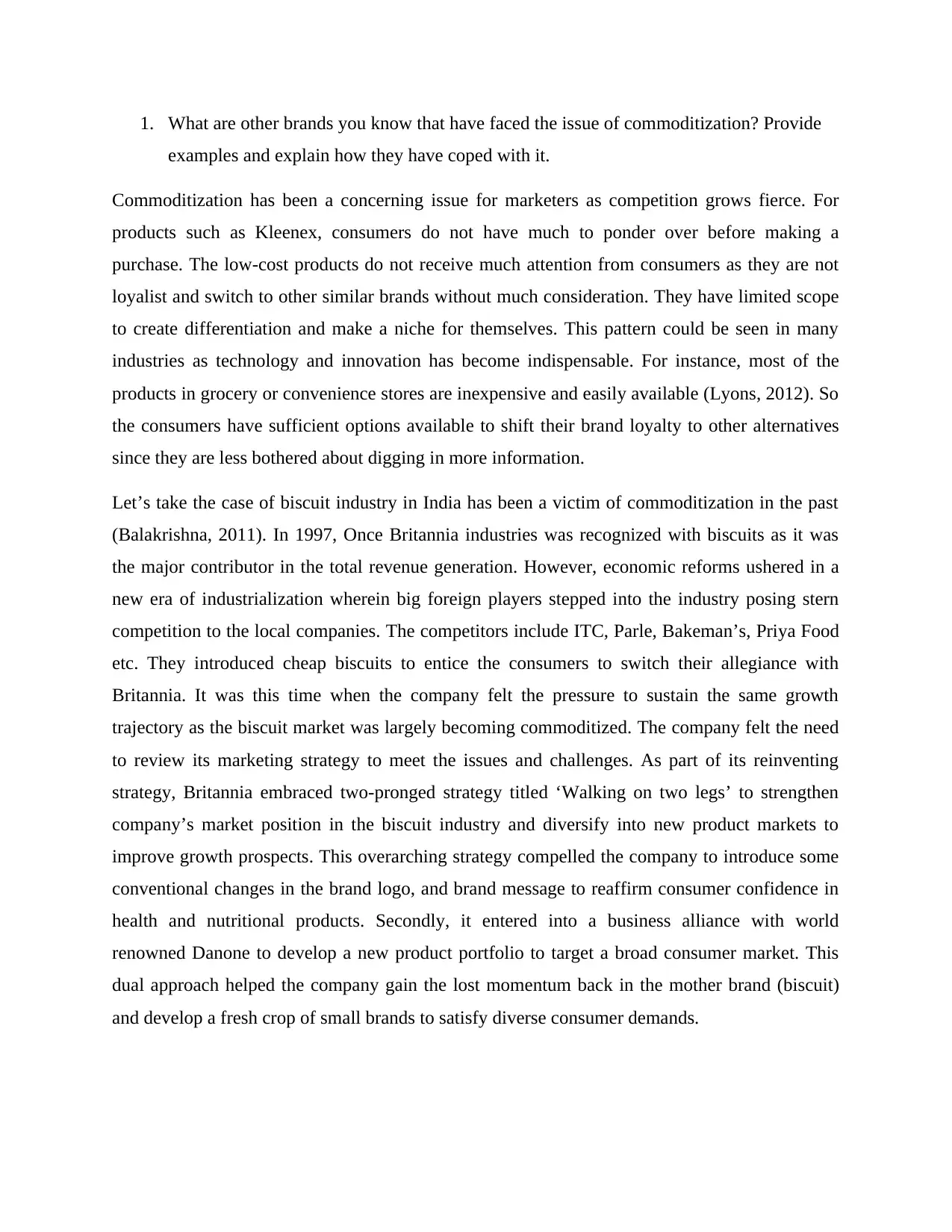
1. What are other brands you know that have faced the issue of commoditization? Provide
examples and explain how they have coped with it.
Commoditization has been a concerning issue for marketers as competition grows fierce. For
products such as Kleenex, consumers do not have much to ponder over before making a
purchase. The low-cost products do not receive much attention from consumers as they are not
loyalist and switch to other similar brands without much consideration. They have limited scope
to create differentiation and make a niche for themselves. This pattern could be seen in many
industries as technology and innovation has become indispensable. For instance, most of the
products in grocery or convenience stores are inexpensive and easily available (Lyons, 2012). So
the consumers have sufficient options available to shift their brand loyalty to other alternatives
since they are less bothered about digging in more information.
Let’s take the case of biscuit industry in India has been a victim of commoditization in the past
(Balakrishna, 2011). In 1997, Once Britannia industries was recognized with biscuits as it was
the major contributor in the total revenue generation. However, economic reforms ushered in a
new era of industrialization wherein big foreign players stepped into the industry posing stern
competition to the local companies. The competitors include ITC, Parle, Bakeman’s, Priya Food
etc. They introduced cheap biscuits to entice the consumers to switch their allegiance with
Britannia. It was this time when the company felt the pressure to sustain the same growth
trajectory as the biscuit market was largely becoming commoditized. The company felt the need
to review its marketing strategy to meet the issues and challenges. As part of its reinventing
strategy, Britannia embraced two-pronged strategy titled ‘Walking on two legs’ to strengthen
company’s market position in the biscuit industry and diversify into new product markets to
improve growth prospects. This overarching strategy compelled the company to introduce some
conventional changes in the brand logo, and brand message to reaffirm consumer confidence in
health and nutritional products. Secondly, it entered into a business alliance with world
renowned Danone to develop a new product portfolio to target a broad consumer market. This
dual approach helped the company gain the lost momentum back in the mother brand (biscuit)
and develop a fresh crop of small brands to satisfy diverse consumer demands.
examples and explain how they have coped with it.
Commoditization has been a concerning issue for marketers as competition grows fierce. For
products such as Kleenex, consumers do not have much to ponder over before making a
purchase. The low-cost products do not receive much attention from consumers as they are not
loyalist and switch to other similar brands without much consideration. They have limited scope
to create differentiation and make a niche for themselves. This pattern could be seen in many
industries as technology and innovation has become indispensable. For instance, most of the
products in grocery or convenience stores are inexpensive and easily available (Lyons, 2012). So
the consumers have sufficient options available to shift their brand loyalty to other alternatives
since they are less bothered about digging in more information.
Let’s take the case of biscuit industry in India has been a victim of commoditization in the past
(Balakrishna, 2011). In 1997, Once Britannia industries was recognized with biscuits as it was
the major contributor in the total revenue generation. However, economic reforms ushered in a
new era of industrialization wherein big foreign players stepped into the industry posing stern
competition to the local companies. The competitors include ITC, Parle, Bakeman’s, Priya Food
etc. They introduced cheap biscuits to entice the consumers to switch their allegiance with
Britannia. It was this time when the company felt the pressure to sustain the same growth
trajectory as the biscuit market was largely becoming commoditized. The company felt the need
to review its marketing strategy to meet the issues and challenges. As part of its reinventing
strategy, Britannia embraced two-pronged strategy titled ‘Walking on two legs’ to strengthen
company’s market position in the biscuit industry and diversify into new product markets to
improve growth prospects. This overarching strategy compelled the company to introduce some
conventional changes in the brand logo, and brand message to reaffirm consumer confidence in
health and nutritional products. Secondly, it entered into a business alliance with world
renowned Danone to develop a new product portfolio to target a broad consumer market. This
dual approach helped the company gain the lost momentum back in the mother brand (biscuit)
and develop a fresh crop of small brands to satisfy diverse consumer demands.
Paraphrase This Document
Need a fresh take? Get an instant paraphrase of this document with our AI Paraphraser
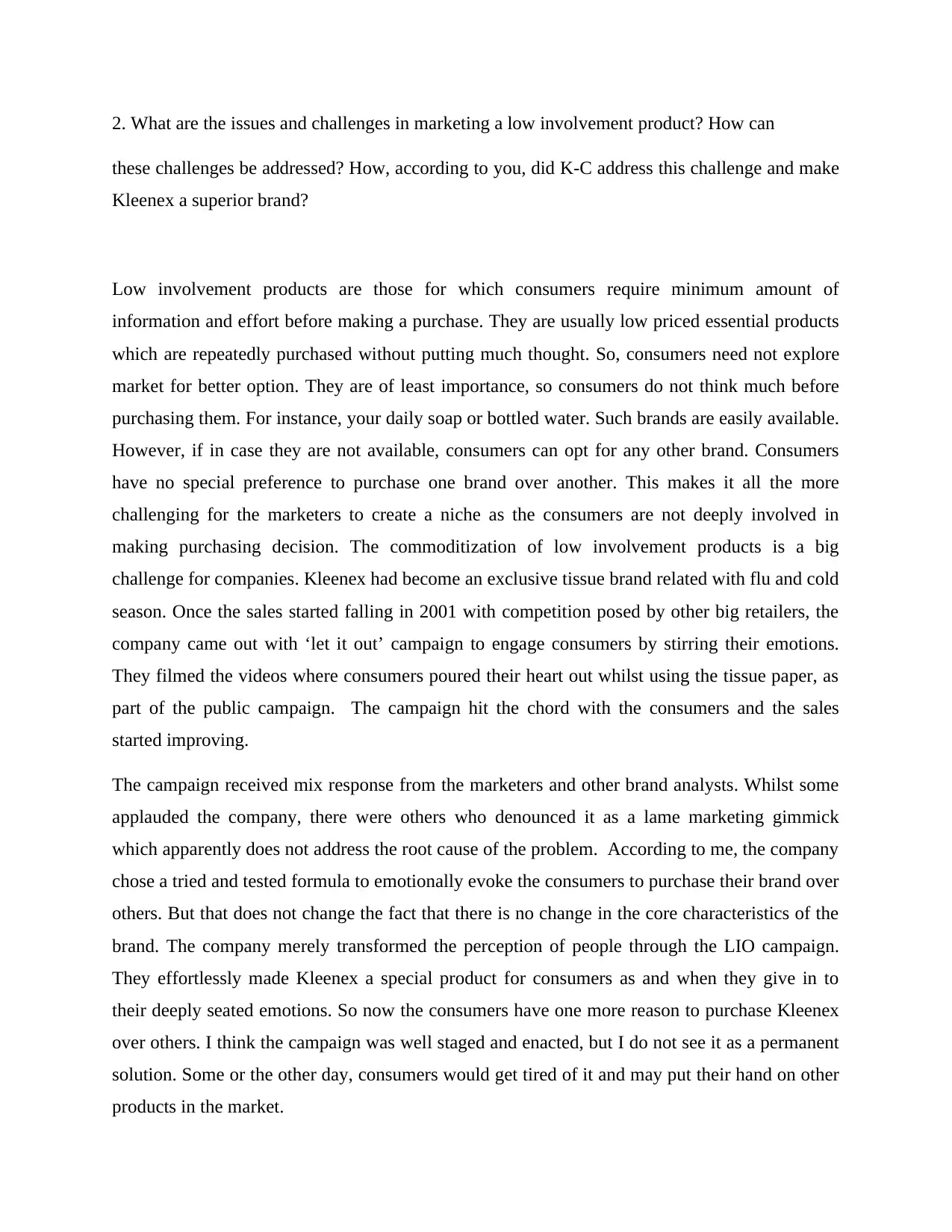
2. What are the issues and challenges in marketing a low involvement product? How can
these challenges be addressed? How, according to you, did K-C address this challenge and make
Kleenex a superior brand?
Low involvement products are those for which consumers require minimum amount of
information and effort before making a purchase. They are usually low priced essential products
which are repeatedly purchased without putting much thought. So, consumers need not explore
market for better option. They are of least importance, so consumers do not think much before
purchasing them. For instance, your daily soap or bottled water. Such brands are easily available.
However, if in case they are not available, consumers can opt for any other brand. Consumers
have no special preference to purchase one brand over another. This makes it all the more
challenging for the marketers to create a niche as the consumers are not deeply involved in
making purchasing decision. The commoditization of low involvement products is a big
challenge for companies. Kleenex had become an exclusive tissue brand related with flu and cold
season. Once the sales started falling in 2001 with competition posed by other big retailers, the
company came out with ‘let it out’ campaign to engage consumers by stirring their emotions.
They filmed the videos where consumers poured their heart out whilst using the tissue paper, as
part of the public campaign. The campaign hit the chord with the consumers and the sales
started improving.
The campaign received mix response from the marketers and other brand analysts. Whilst some
applauded the company, there were others who denounced it as a lame marketing gimmick
which apparently does not address the root cause of the problem. According to me, the company
chose a tried and tested formula to emotionally evoke the consumers to purchase their brand over
others. But that does not change the fact that there is no change in the core characteristics of the
brand. The company merely transformed the perception of people through the LIO campaign.
They effortlessly made Kleenex a special product for consumers as and when they give in to
their deeply seated emotions. So now the consumers have one more reason to purchase Kleenex
over others. I think the campaign was well staged and enacted, but I do not see it as a permanent
solution. Some or the other day, consumers would get tired of it and may put their hand on other
products in the market.
these challenges be addressed? How, according to you, did K-C address this challenge and make
Kleenex a superior brand?
Low involvement products are those for which consumers require minimum amount of
information and effort before making a purchase. They are usually low priced essential products
which are repeatedly purchased without putting much thought. So, consumers need not explore
market for better option. They are of least importance, so consumers do not think much before
purchasing them. For instance, your daily soap or bottled water. Such brands are easily available.
However, if in case they are not available, consumers can opt for any other brand. Consumers
have no special preference to purchase one brand over another. This makes it all the more
challenging for the marketers to create a niche as the consumers are not deeply involved in
making purchasing decision. The commoditization of low involvement products is a big
challenge for companies. Kleenex had become an exclusive tissue brand related with flu and cold
season. Once the sales started falling in 2001 with competition posed by other big retailers, the
company came out with ‘let it out’ campaign to engage consumers by stirring their emotions.
They filmed the videos where consumers poured their heart out whilst using the tissue paper, as
part of the public campaign. The campaign hit the chord with the consumers and the sales
started improving.
The campaign received mix response from the marketers and other brand analysts. Whilst some
applauded the company, there were others who denounced it as a lame marketing gimmick
which apparently does not address the root cause of the problem. According to me, the company
chose a tried and tested formula to emotionally evoke the consumers to purchase their brand over
others. But that does not change the fact that there is no change in the core characteristics of the
brand. The company merely transformed the perception of people through the LIO campaign.
They effortlessly made Kleenex a special product for consumers as and when they give in to
their deeply seated emotions. So now the consumers have one more reason to purchase Kleenex
over others. I think the campaign was well staged and enacted, but I do not see it as a permanent
solution. Some or the other day, consumers would get tired of it and may put their hand on other
products in the market.
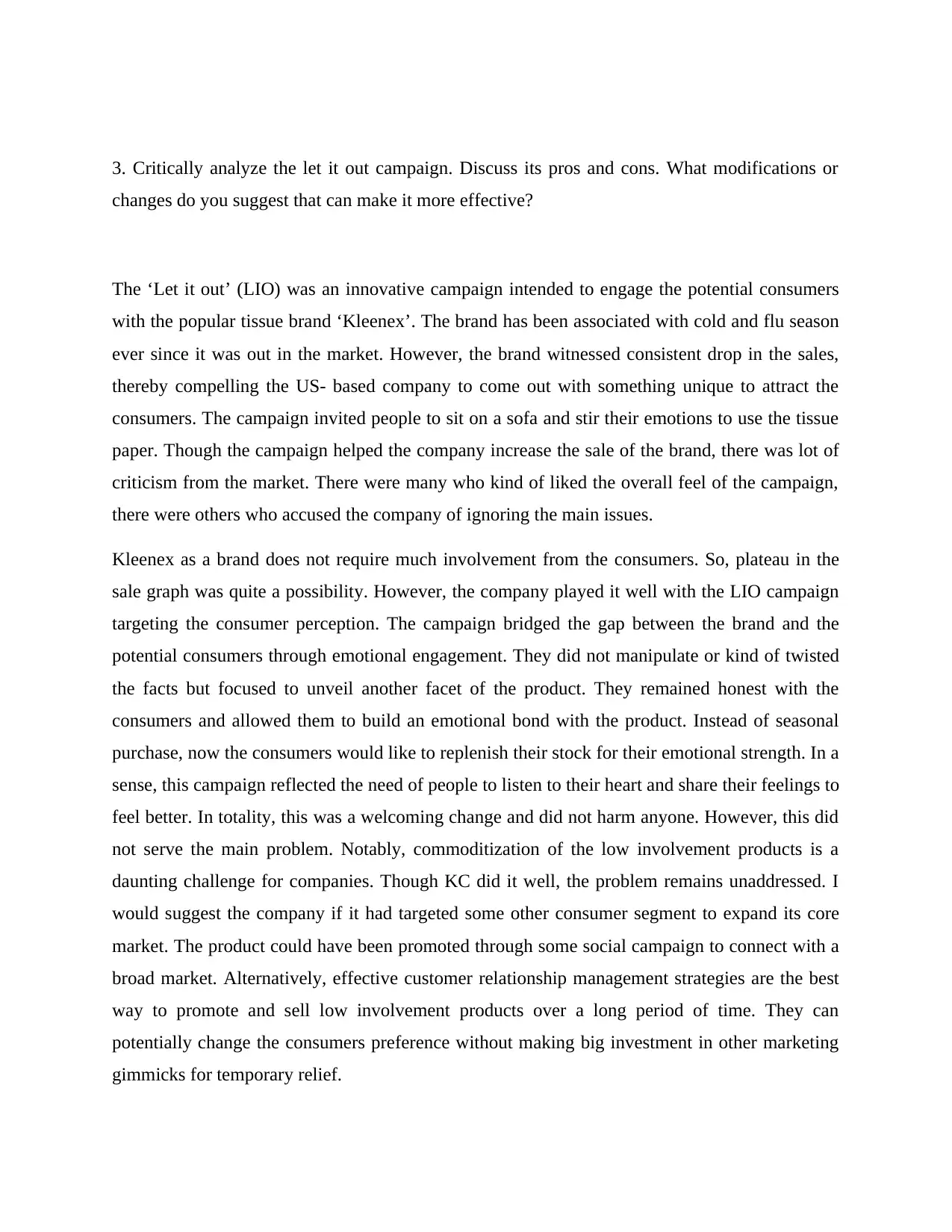
3. Critically analyze the let it out campaign. Discuss its pros and cons. What modifications or
changes do you suggest that can make it more effective?
The ‘Let it out’ (LIO) was an innovative campaign intended to engage the potential consumers
with the popular tissue brand ‘Kleenex’. The brand has been associated with cold and flu season
ever since it was out in the market. However, the brand witnessed consistent drop in the sales,
thereby compelling the US- based company to come out with something unique to attract the
consumers. The campaign invited people to sit on a sofa and stir their emotions to use the tissue
paper. Though the campaign helped the company increase the sale of the brand, there was lot of
criticism from the market. There were many who kind of liked the overall feel of the campaign,
there were others who accused the company of ignoring the main issues.
Kleenex as a brand does not require much involvement from the consumers. So, plateau in the
sale graph was quite a possibility. However, the company played it well with the LIO campaign
targeting the consumer perception. The campaign bridged the gap between the brand and the
potential consumers through emotional engagement. They did not manipulate or kind of twisted
the facts but focused to unveil another facet of the product. They remained honest with the
consumers and allowed them to build an emotional bond with the product. Instead of seasonal
purchase, now the consumers would like to replenish their stock for their emotional strength. In a
sense, this campaign reflected the need of people to listen to their heart and share their feelings to
feel better. In totality, this was a welcoming change and did not harm anyone. However, this did
not serve the main problem. Notably, commoditization of the low involvement products is a
daunting challenge for companies. Though KC did it well, the problem remains unaddressed. I
would suggest the company if it had targeted some other consumer segment to expand its core
market. The product could have been promoted through some social campaign to connect with a
broad market. Alternatively, effective customer relationship management strategies are the best
way to promote and sell low involvement products over a long period of time. They can
potentially change the consumers preference without making big investment in other marketing
gimmicks for temporary relief.
changes do you suggest that can make it more effective?
The ‘Let it out’ (LIO) was an innovative campaign intended to engage the potential consumers
with the popular tissue brand ‘Kleenex’. The brand has been associated with cold and flu season
ever since it was out in the market. However, the brand witnessed consistent drop in the sales,
thereby compelling the US- based company to come out with something unique to attract the
consumers. The campaign invited people to sit on a sofa and stir their emotions to use the tissue
paper. Though the campaign helped the company increase the sale of the brand, there was lot of
criticism from the market. There were many who kind of liked the overall feel of the campaign,
there were others who accused the company of ignoring the main issues.
Kleenex as a brand does not require much involvement from the consumers. So, plateau in the
sale graph was quite a possibility. However, the company played it well with the LIO campaign
targeting the consumer perception. The campaign bridged the gap between the brand and the
potential consumers through emotional engagement. They did not manipulate or kind of twisted
the facts but focused to unveil another facet of the product. They remained honest with the
consumers and allowed them to build an emotional bond with the product. Instead of seasonal
purchase, now the consumers would like to replenish their stock for their emotional strength. In a
sense, this campaign reflected the need of people to listen to their heart and share their feelings to
feel better. In totality, this was a welcoming change and did not harm anyone. However, this did
not serve the main problem. Notably, commoditization of the low involvement products is a
daunting challenge for companies. Though KC did it well, the problem remains unaddressed. I
would suggest the company if it had targeted some other consumer segment to expand its core
market. The product could have been promoted through some social campaign to connect with a
broad market. Alternatively, effective customer relationship management strategies are the best
way to promote and sell low involvement products over a long period of time. They can
potentially change the consumers preference without making big investment in other marketing
gimmicks for temporary relief.
⊘ This is a preview!⊘
Do you want full access?
Subscribe today to unlock all pages.

Trusted by 1+ million students worldwide
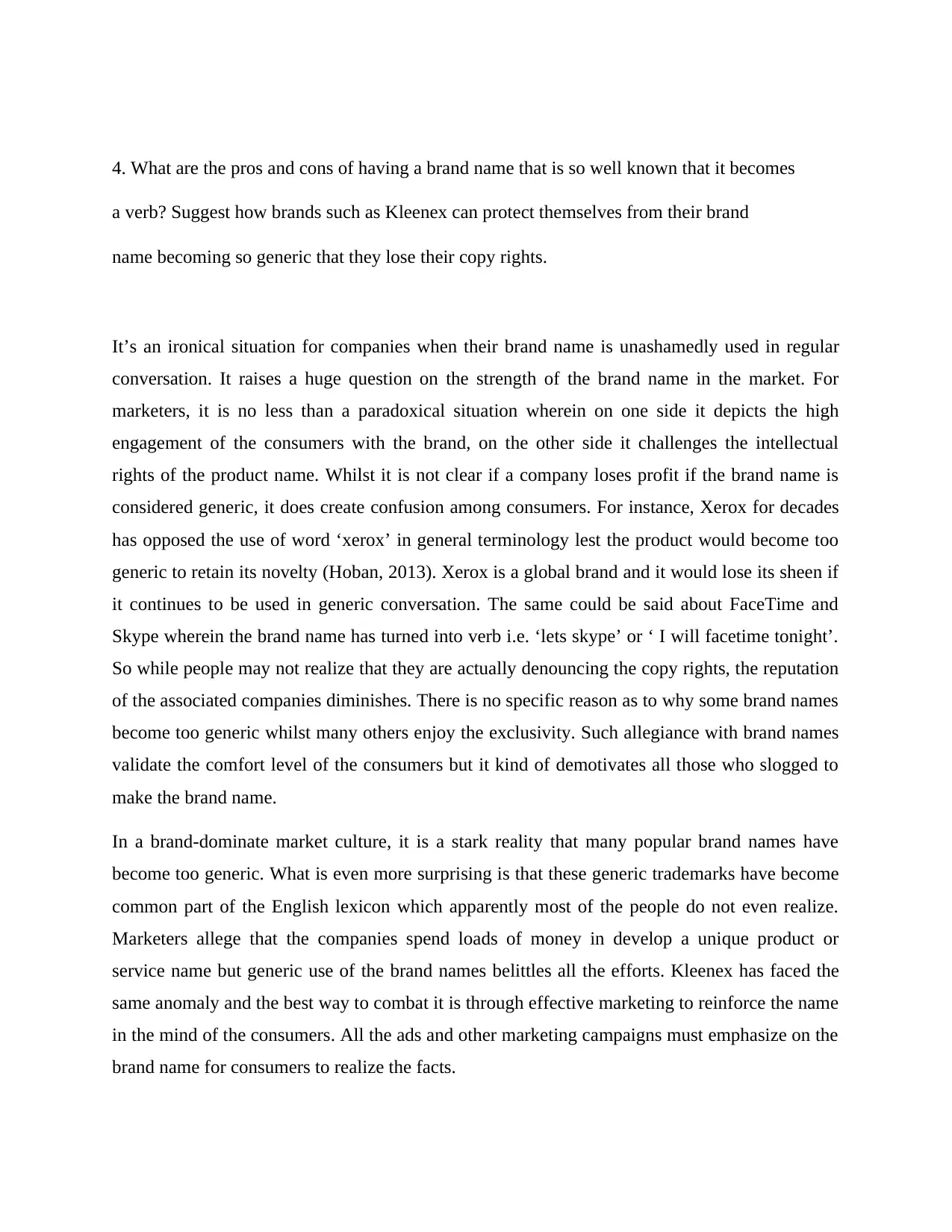
4. What are the pros and cons of having a brand name that is so well known that it becomes
a verb? Suggest how brands such as Kleenex can protect themselves from their brand
name becoming so generic that they lose their copy rights.
It’s an ironical situation for companies when their brand name is unashamedly used in regular
conversation. It raises a huge question on the strength of the brand name in the market. For
marketers, it is no less than a paradoxical situation wherein on one side it depicts the high
engagement of the consumers with the brand, on the other side it challenges the intellectual
rights of the product name. Whilst it is not clear if a company loses profit if the brand name is
considered generic, it does create confusion among consumers. For instance, Xerox for decades
has opposed the use of word ‘xerox’ in general terminology lest the product would become too
generic to retain its novelty (Hoban, 2013). Xerox is a global brand and it would lose its sheen if
it continues to be used in generic conversation. The same could be said about FaceTime and
Skype wherein the brand name has turned into verb i.e. ‘lets skype’ or ‘ I will facetime tonight’.
So while people may not realize that they are actually denouncing the copy rights, the reputation
of the associated companies diminishes. There is no specific reason as to why some brand names
become too generic whilst many others enjoy the exclusivity. Such allegiance with brand names
validate the comfort level of the consumers but it kind of demotivates all those who slogged to
make the brand name.
In a brand-dominate market culture, it is a stark reality that many popular brand names have
become too generic. What is even more surprising is that these generic trademarks have become
common part of the English lexicon which apparently most of the people do not even realize.
Marketers allege that the companies spend loads of money in develop a unique product or
service name but generic use of the brand names belittles all the efforts. Kleenex has faced the
same anomaly and the best way to combat it is through effective marketing to reinforce the name
in the mind of the consumers. All the ads and other marketing campaigns must emphasize on the
brand name for consumers to realize the facts.
a verb? Suggest how brands such as Kleenex can protect themselves from their brand
name becoming so generic that they lose their copy rights.
It’s an ironical situation for companies when their brand name is unashamedly used in regular
conversation. It raises a huge question on the strength of the brand name in the market. For
marketers, it is no less than a paradoxical situation wherein on one side it depicts the high
engagement of the consumers with the brand, on the other side it challenges the intellectual
rights of the product name. Whilst it is not clear if a company loses profit if the brand name is
considered generic, it does create confusion among consumers. For instance, Xerox for decades
has opposed the use of word ‘xerox’ in general terminology lest the product would become too
generic to retain its novelty (Hoban, 2013). Xerox is a global brand and it would lose its sheen if
it continues to be used in generic conversation. The same could be said about FaceTime and
Skype wherein the brand name has turned into verb i.e. ‘lets skype’ or ‘ I will facetime tonight’.
So while people may not realize that they are actually denouncing the copy rights, the reputation
of the associated companies diminishes. There is no specific reason as to why some brand names
become too generic whilst many others enjoy the exclusivity. Such allegiance with brand names
validate the comfort level of the consumers but it kind of demotivates all those who slogged to
make the brand name.
In a brand-dominate market culture, it is a stark reality that many popular brand names have
become too generic. What is even more surprising is that these generic trademarks have become
common part of the English lexicon which apparently most of the people do not even realize.
Marketers allege that the companies spend loads of money in develop a unique product or
service name but generic use of the brand names belittles all the efforts. Kleenex has faced the
same anomaly and the best way to combat it is through effective marketing to reinforce the name
in the mind of the consumers. All the ads and other marketing campaigns must emphasize on the
brand name for consumers to realize the facts.
Paraphrase This Document
Need a fresh take? Get an instant paraphrase of this document with our AI Paraphraser
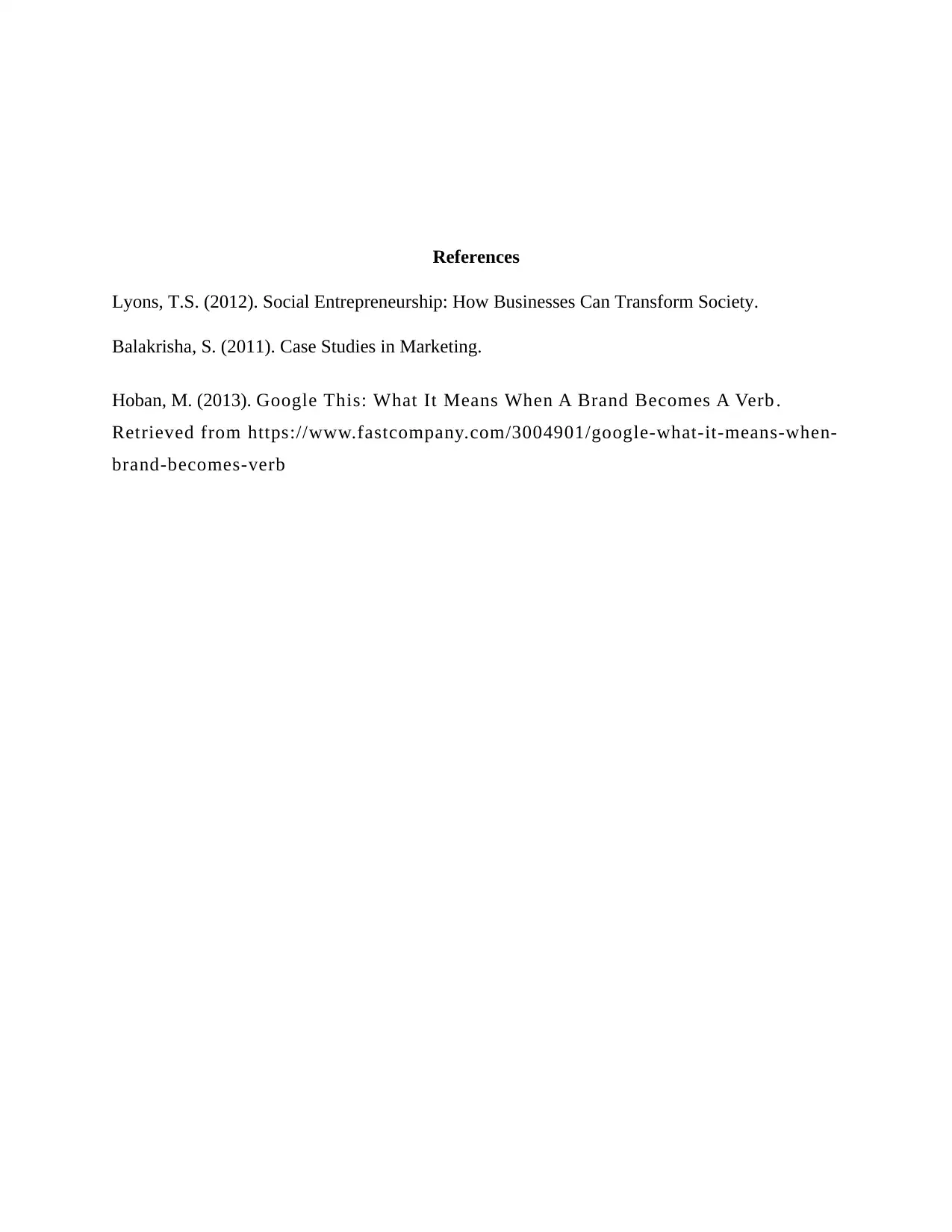
References
Lyons, T.S. (2012). Social Entrepreneurship: How Businesses Can Transform Society.
Balakrisha, S. (2011). Case Studies in Marketing.
Hoban, M. (2013). Google This: What It Means When A Brand Becomes A Verb .
Retrieved from https://www.fastcompany.com/3004901/google-what-it-means-when-
brand-becomes-verb
Lyons, T.S. (2012). Social Entrepreneurship: How Businesses Can Transform Society.
Balakrisha, S. (2011). Case Studies in Marketing.
Hoban, M. (2013). Google This: What It Means When A Brand Becomes A Verb .
Retrieved from https://www.fastcompany.com/3004901/google-what-it-means-when-
brand-becomes-verb
1 out of 5
Related Documents
Your All-in-One AI-Powered Toolkit for Academic Success.
+13062052269
info@desklib.com
Available 24*7 on WhatsApp / Email
![[object Object]](/_next/static/media/star-bottom.7253800d.svg)
Unlock your academic potential
Copyright © 2020–2025 A2Z Services. All Rights Reserved. Developed and managed by ZUCOL.

